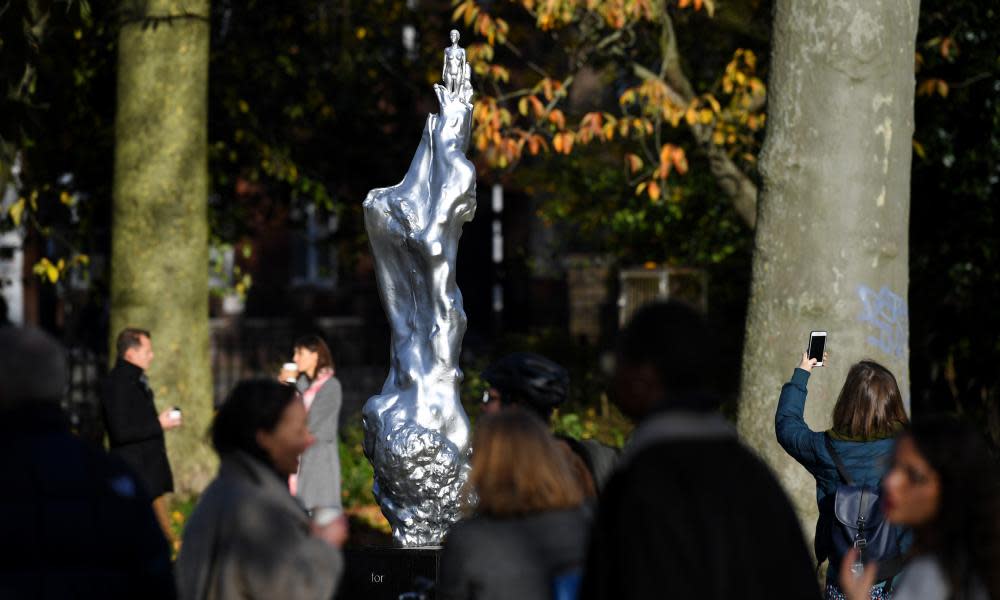In these days of scrolling and outrage, have we lost our ability to discuss art?

Three weeks ago – ancient history in the opinion cycle – Maggi Hambling’s sculpture for Mary Wollstonecraft was unveiled on Newington Green in north London. I say “unveiled”, but it was really more a question of the sculpture being set loose.
First it was photographed in truncated, misleading closeup, then it was exposed, via news sites and social media, to the glare of fevered and largely hostile public opinion. Even with clarification that the naked figure atop a gout of primordial matter was not, in fact, Wollstonecraft herself, but an “everywoman”, few found this attempt to redress the entrenched misogyny of public art and memorial successful. Why did this everywoman need to be naked? And even if she had to be naked, why did she need to be so toned? Was this how we wanted to memorialise a foundational feminist thinker, with yet another idealised and inexplicably denuded female body?
Watching what half-jokingly came to be referred to as “statue discourse” take off, largely online, at unsustainable speed, then dwindle within a couple of days, I experienced a sense of weariness and mild frustration. It felt as if this was happening too quickly, as if the 10-year time frame of planning, fundraising and creation that produced the sculpture had been awkwardly collapsed into the meagre response-space of contemporary reaction. Is this, I wondered, the natural end point for all art in the new media age – the flattening of every discipline into uniform packages of content, the erasure of any discernible qualitative difference between a controversial sculpture and a bad tweet, a painting and a 600-word opinion column screenshotted down to a single sentence?
Related: ‘I need complete freedom’: Maggi Hambling responds to statue critics
Were I to respond with equal speed to my initial impression of the statue not as object but as event, you can see immediately how I might spin from it a predictable line of concern. I could talk about “outrage”. I could fret, as is fashionable these days, about a “stifling” or “puritanical” online atmosphere. I could perhaps even conclude that the statue, and by extension its maker and fundraisers, had been “cancelled”. From here it would be fairly straightforward to issue a dire warning about the future of art in these precious, hyperwoke times.
To do so, though, would be to apply my own process of reduction. The truth is, I enjoyed “the discourse”. More importantly, I learned from it. I read responses to the work from historians, biographers, critics, scholars. I read discussions about the place of the female nude in the history of art, the limitations of the figurative and the possibilities of the abstract in public art. I also read context: the history of the campaign to fundraise for this sculpture, the reasons previous designs were rejected. Naturally, this required a bit of time, not to mention a conscious screening out of however many other discourses were ablaze at that particular instant. But if we’re committed, as we should be, to engaging closely with what art offers and gives rise to, does it not stand to reason that to invest attention into the conversation that surrounds an artwork is simply to extend the attention we offer the artwork itself?
In all the discourse about the state of the discourse, two largely unchallenged cliches hold sway: that we live in an accelerated age, and that our society is increasingly, perhaps even terminally, “polarised”, as if we are all travelling away from each other at great speed. Often, one or both of these increasingly unchallenged positions are deployed in the defence of art. Our age of acceleration, it’s suggested, is not conducive to the appreciation of culture, and our culture of outrage is unsuited to reasoned debate. In this framing, art and literature tend to be the losers, squeezed out by velocity and bombast, shortened attention spans and hair-trigger Twitter fingers.
Examining my own initial response to the statue clamour, though, and noting how quickly it could calcify into exactly the kind of reactionary position beloved of the culture war brigade, I find myself wondering if we may need to worry less about the internet’s tendency towards reaction, and more about our own in-built reactivity to reaction itself. What if all the truisms about acceleration and outrage are really just a mask for a far more traditionalist concern – fear of conflict, suspicion of dissent – and what if that fear blinds us to an alternative possible truth: that the processes of reception, judgment, and consensus haven’t merely been accelerated, but distilled, so that while the space they occupy may be smaller, their substance is in fact richer?
Internet reactivity isn’t going anywhere. We can’t simply roll back the years to some imagined and largely fictitious time of broad cultural consensus. The vision of a society in which people either agree outright or disagree only within agreed parameters of divergence is both a mirage and actually a nightmare.
Rather than recoiling from the noise of outcry, then, perhaps we might try, as both artists and audience, leaning into it, and even absorbing it into the very experience of art. In this conception of the future, we would invest our energy not in dampening down the noise, or blocking our ears to the clamour, but revelling in its disorder, accepting that the process of being born into and through, a churning, primordial chaos of response, is simply one stage in the journey of both artworks and ideas, from which they will emerge tarnished but probably not destroyed, or – much like Hambling’s nude atop her mountain of frothing, fertile matter – stress-tested and freshly resplendent, polished not by reverence, but by the productive friction of a necessarily troubled emergence.
• Sam Byers is the author of Come Join our Disease, Perfidious Albion and Idiopathy


